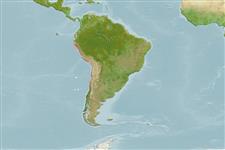Common names from other countries
Environment: milieu / climate zone / depth range / distribution range
Ecologia
; intervalo de profundidade 0 - 20 m (Ref. 114693). Tropical, preferred 15°C (Ref. 107945); 5°S - 43°S, 81°W - 70°W (Ref. 114682)
Southern Pacific: From Sechura, Peru to Chiloé, Chile. Tropical and subtropical.
Length at first maturity / Tamanho / Peso / Idade
Maturity: Lm ? range ? - ? cm Max length : 7.0 cm ShL macho/indeterminado; (Ref. )
Lives in the swash zone of exposed high-energy intermediate and dissipative sandy beaches. Usually burrows to a depth of around 10 cm, but can reach 25 cm if disturbed. Adults are mainly restricted to the surf zone while most of the juveniles to the swash zone (Ref. 106909). Intertidal to subtidal (Ref. 113820).
Life cycle and mating behavior
Maturidade | Reprodução | Desova | Ovos | Fecundidade | Larvas
Members of the class Bivalvia are mostly gonochoric, some are protandric hermaphrodites. Life cycle: Embryos develop into free-swimming trocophore larvae, succeeded by the bivalve veliger, resembling a miniature clam.
SAUP Database. 2006. (Ref. 356)
Status na Lista Vermelha da IUCN (Ref. 130435)
Status no CITES (Ref. 108899)
Not Evaluated
Not Evaluated
Uso pelos humanos
Pescarias: espécies comerciais
FAO - pescarias: landings | FishSource | Sea Around Us
Ferramentas
Mais informação
Idade/TamanhoCrescimentoComprimento-pesoComprimento-comprimentoMorfologiaLarvasAbundância
Fontes da internet
Estimates based on models
Preferred temperature
(Ref.
115969): 11.8 - 21.9, mean 17.4 (based on 30 cells).
Resiliência
Elevada, tempo mínimo de duplicação da população menor que 15 meses (K=1.13).
Vulnerabilidade
Low vulnerability (10 of 100).
